Electricity exercises
Read and complete:
Voltage and current
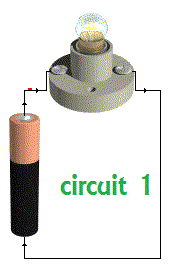
A battery is a source of electrical energy – it provides the ‘pressure’ which causes electricity to flow. We measure this electrical pressure in volts, V. The higher the voltage, the greater the pressure.
The flow of electricity is called current and is measured in amps, A.
If a single battery makes a bulb glow dimly, two batteries connected in series as in circuit bellow will make it glow brighter. In the next circuit, 4 batteries are connected in series so the total tension will be V1 + V2 + V3 + V4.
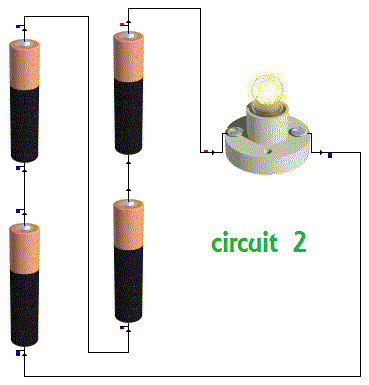
This happens because when batteries are connected in series their voltages ‘add up’. Four similar batteries connected in series ( circuit 2 ) produce 4 times the electrical pressure.
The greater the electrical pressure (in a given circuit) the higher the current.
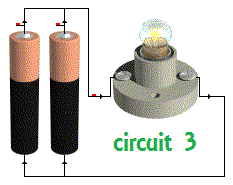
When batteries are connected in parallel however, their voltages do not ‘add up’. The voltage provided by the two batteries in circuit 3 is the same as by the single battery in circuit 1.
Even so, there are reasons for connecting batteries in parallel: two batteries last longer than one, and can supply a higher current, should it be required.
Read 3 or 4 times. Later, do this ![]() exercise
exercise
Calculate the equivalent resistor and the current in the battery.
Remember: In a series circuit, the total resistance of the circuit (also called effective resistance) is equal to the sum of the individual resistances, so Re = R1 + R2 + R3 …
In a parallel circuit, a quicker method of finding the equivalent resistance is to use the general formula:
1 / Re = 1/R1 + 1/R2 + 1/R3 …..
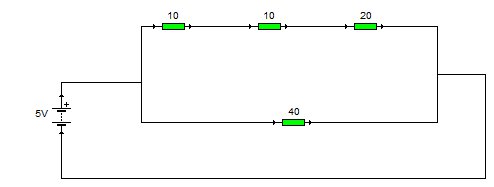 Solution: Re = 20 Ω I = 250 mA
Solution: Re = 20 Ω I = 250 mA
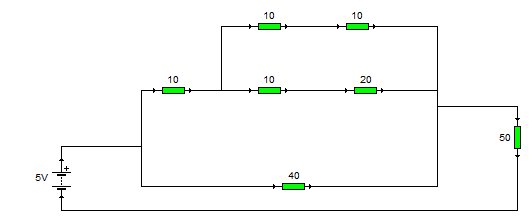 Re = 64,18 Ω I = 77,9 mA
Re = 64,18 Ω I = 77,9 mA
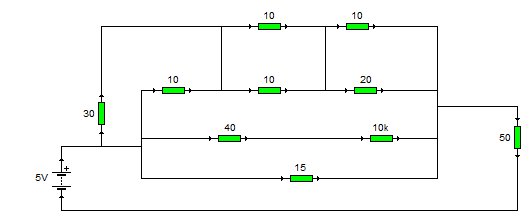 Re = 58,41 Ω I = 85,6 mA
Re = 58,41 Ω I = 85,6 mA
1º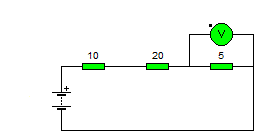 In this circuit, the value of the battery is 10 Volts and the current measured in the ammeter is 2 mA.
In this circuit, the value of the battery is 10 Volts and the current measured in the ammeter is 2 mA.
a) Calculate the value of Resistor 1 in this circuit.
b) How much current would flow if the value of R was doubled?
Solutions: R = 5 KΩ and b) I = 1 mA

2º Calculate the current flowing in this circuit.
b) What would be the ammeter reading if the resistor’s value was halved?
Solutions: a) 200 mA b) 400 mA
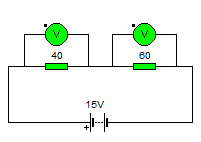
3º a) Calculate the current flowing through the 40 Ohms resistor.
b) Calculate the current flowing through the 60 Ohms resistor.
c) What will be the reading on the current in the battery?
d ) What is the total resistance in this circuit?
Solutions: V1 = 6 volts b) V2 = 9 volts c) 150 mA d) Rt = 100 Ω
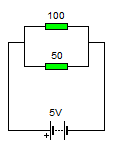
4º What will be the value of the current flowing through the 100 Ohm resistor?
And what about the current in the other resistor?
Solutions: 50 mA and 100 mA

6º We have a two parallel resistors. Calculate the total resistance of the circuit and the current flowing through each resister.
Solutions: Rt = 33,33 Ω, I1 = 0,05 A and I2 = 0,1 A
7º A series circuit has 4 resistances of 20, 40, 10 and 5 Ohms. Calculate the Total resistance and the current flowing through each one if the battery has a value of 10 Volts
Solutions: Total resistance = 75 Ω. I = 0,13 Amps
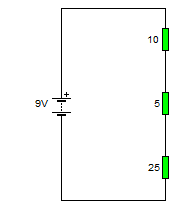
8º In this circuit, calculate:
a ) The total resistance in the circuit
b) The current flowing in the circuit.
c) The voltage across every resistor
Solutions:
a) = 40 Ω b) = 0,225 A c ) V1 = 2,25 V2 =1,125 V3 = 5,625
Note: If you ad V1 plus V2 plus V3, you get the Battery voltage
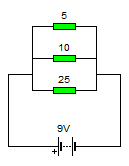
9º 5 ,10 and 25 Ohms resistors are connected in parallel. Calculate the total resistance and the current flowing through each one
Solutions: Rt = 2,94 Ω I1 = 1,8 A I2 = 0,9 A and I3 = 0,36 A

10º In the circuit on the left, we have 3 series resistors. We measure 8 volts in the voltmeter ( represented by V ).
Calculate the voltage across the 20 Ω resistance
V = 32 V
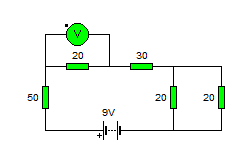
11º In the next circuit , calculate the voltage across the 20 Ohm resistor.
Solution: 1,64 volts
12º What is The electric power?. How it is measured?
13º A hair dryer has a resistance of 100 Ω and it is plugged to a 220 mains supply. If it is operating for 40 minutes, calculate how many kilowatts per hour of energy does it use and how much do you pay if 1kwh = 0,20€.
14º What resistor values are indicated by the following colour bands? (A) Blue, black, yellow
15º The atom
16º Conductors and Insulators. Examples
17º Types of currents
18º Define Resistance, Current and voltage.
19ª Ohm law
